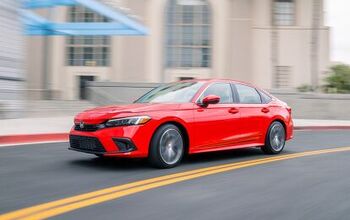Toyota Prius Shortage Explained
Remember when we told you Toyota would be dropping $673m on new battery facilities? In addition to expanding next-gen Li-ion production (and next-next-gen development labs), ToMoCo also wants to increase its current-spec NiMH production capacity. And no wonder. Toyota can't keep the NiMH batteries in stock, limiting sales of its hybrid lineup. The AP reports via the San Jose Mercury that Toyota's investments in production capacity won't bear fruit until next year. "Hybrids are selling so well we are doing all we can to increase production," says executive VP for production Takeshi Uchiyamada. "We need new lines." But the ramifications of Toyota's lack of insight (pun kinda intended) aren't limited to lost sales. Uchiyamada acknowledges that white-hot demand for the NiMH packs are preventing him from extending Toyota's production-greening efforts to the production of "green" hybrid cars. (Figure that one out.) As the industry pioneer in hybrid manufacturing, Toyota's battery shortage is clearly a measure of its product's success. On the other hand, as a longtime leader in production efficiency, it's hard to believe Toyota was caught napping by demand for its hybrids. It seems that when it comes to hybrids, Toyota's "just-in-time" ethic translates a little closer to "hurry up and wait."
More by Edward Niedermeyer


































Comments
Join the conversation
marc, Some companies are great. Some companies are big. It's really tough to be both. Toyota his hit some hiccups over the last 24 months as a result of being a big company. Let's see how they perform against great companies like Honda in the long run. Fortunately for Toyota, there aren't a lot of great car companies they compete with here in the US. And the consumer is worse off for it.
>>"For some reason, Detroit loves to hang on to old models when the new one comes out. " Well, in the case of the Grand Cherokee being the top of the line family Jeep wagon, its entry exactly coincided with the ceasing of production of its predecessor in that niche: the Jeep Grand Wagoneer. The GW is arguably the original luxo SUV, having been around in one flavor or another since 1963. 1963-1991; A 28-year platform lifespan that, as things stand now, will never be exceeded by any SUV. (Although it may be exceeded by GM mid-size FWD platforms at this rate...) Even in today's movies & tv shows you can still see in the backround parked in the set's suburban house driveway a wood-panel-sided GW; it's become the archetypical family truckster, even 17 years out of production. In fact, already off-topic as I am, I nominate this 13mpg highway wonder, with its high torque and relatively low hp, as a retrospective review model for TTAC.
Here in Australia the Prius dominates (our government just gave Toyota 35 Million to make hybrids here). But in my Dealership the Civic Hybrid is flying out the door. We have a two month wait for the things. The Civic Hybrid will be number two in the marketplace for a while yet but i sure dont mind. It helps that the Civic undercuts the price of the Prius by 7K here. Thats a big difference.
"... sell more if they improve looks." Weight and CD are top priorities. The orginal Volt wasn't close to what the producton model will look like. Weight was around 3500 lbs and CD to match. Current Prius CD is .26 and that's pretty good. Most production cars are around .30 and the guzzlers all have CD's to match. The EV1 had a CD OF .195 and that is the mark for electric cars. http://en.wikipedia.org/wiki/Automobile_drag_coefficients